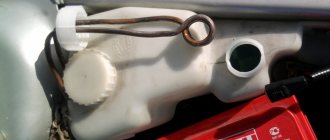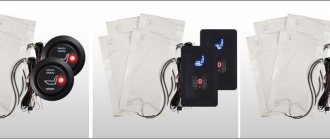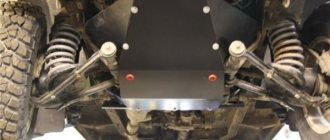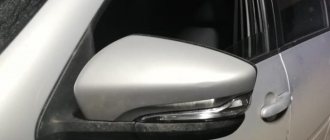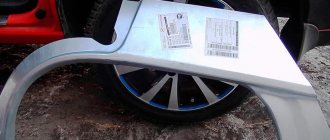Hello, dear friends! I think many of you drivers are familiar with the problem of fogging and freezing of side mirrors. Therefore, today it would be logical to talk about heating mirrors with your own hands.
This is not just an additional option, but sometimes an extreme necessity. It allows you to constantly be aware of what is happening behind you due to a clear picture without distortion from moisture, condensation and stuck snow.
At the same time, heating for a mirror can be implemented in different ways. Before you take the first step in this rule, I suggest exploring several possible options. I’ll briefly tell you what they look like, what they are and how to connect them without turning to specialists for help, who will obviously demand an impressive amount of money to complete the work.
Types of heating
Wire-based heating
It is necessary to purchase tungsten filaments. They must be laid between two layers of insulating material. This creates a spiral. It is necessary to make two conclusions (for plus and minus). When choosing this heating option, you need to have a good understanding of mechanics. The spiral must be insulated; there should be no gaps between the two layers of insulating material.
On printed conductors
This is an easy option for installing heated mirrors since every car market has heated units. They consist of two layers of polymer material, between which conductors are located. Such parts are made for a specific model. They can be found according to the desired size; for this you need to know the parameters of the car.
To install the heating, you will need to disassemble the mirror housing. This is necessary in order to get to the other side. The inner part must be degreased and the board glued to it.
The heaters have two terminals on the sides (wires are connected to them), they must be soldered and insulated. The wires are connected to the wiring, and the heating regulator is displayed on the panel.
Important! Efficiency will be higher if the internal cavity of the housing is covered with foil or heat-insulating material.
Film heater
The most reliable elements today are film heaters. Installation is carried out by analogy with printed conductors. You need to stick a small amount of double-sided tape on the back of the mirrors. Film heaters are available with lead wires. To connect, they need to be connected to the car’s wiring and the button connected to the control panel. The main advantage of the film base is the uniform distribution of heat over the surface of the mirrors.
Selecting a heating element
Of course, for the most part, the heating elements that are installed inside the side mirrors are the same. However, there are differences in the shape and size of the element itself, so if you yourself cannot say with confidence that this particular element will suit you, it is better to consult the seller, since most often heaters are made for specific car models or for entire lines of cars with mirrors of the same size and shape.
If there is no opportunity to consult, then it is better to buy a heating element slightly smaller in size than the mirror surface itself. In this case, you will protect yourself from an unpleasant situation when you have to trim the heater body, which is fraught with depressurization and burnout of the element during operation.
Also, when purchasing, make sure that the voltage and current indicated on the heating element are suitable for powering from your car battery.
Installation of finished components
The installation is clear even to a car driver who has recently driven the car.
Procedure:
- Find a device to close and open the circuit (relay). Open the hood of the vehicle, find the black box and relay. There are indications on the box which relay is for what. You need to find one for the mirrors and remove it. Next, replace the relay with the mirror element, connect the wire, and close the hood.
- Remove old mirrors. Open the doors, unscrew the screws. Find mounting locations for rearview mirrors. Remove old components and disconnect wires.
- Supply purchased components.
Procedure
Now you can begin installing the heater. First, remove the holder with the mirror from the case. On most cars, it is enough to pry it with a screwdriver or something flat from below and pull it towards you.
Based on the characteristics of the holder, we choose the method of fastening the wire. If the inner surface of the holder is smooth (as in the photo), then stick double-sided tape on it.
Then we lay a piece of wire on this surface. This can be done arbitrarily, for example, in a zigzag or something else. The main thing is to place it so that the thread covers as much of the surface of the holder as possible. In this case, the wire should not intersect anywhere. Scotch tape will hold the nichrome thread well.
If the inner surface of the holder has any protrusions or fastening elements, then it will not be possible to stick the tape. In this case, a soldering iron will help to secure the wire. Everything is simple here - we apply a nichrome thread to the surface and press it with a heated soldering iron. The plastic will begin to melt and the wire will sink into it. Once cooled, the plastic will become hard and will hold the thread. But here it is important not to overdo it with heating the plastic, so as not to “push” it to the mirror. It is enough just to “drown” the wire in it a little and that’s it.
We recommend: How can you reduce fuel consumption on a VAZ-2114?
In this way, we fasten the wire along the accessible surface of the holder without touching the fasteners.
When laying the wire, its ends should be placed towards the side of the holder that is closer to the door, and so that they do not touch each other. To these ends we solder terminals for connecting to the wiring or simply the ends of prepared wires. Then the resulting connections need to be insulated.
All that remains is to provide insulation. If the wire was secured with tape, then to insulate it you can simply stick several more layers of regular adhesive tape on top. This will provide thermal insulation and prevent the wire from peeling off and shorting.
As for the holder where the wire is secured with a soldering iron, you can simply fill the entire surface where the thread passes with sealant and wait until it dries. In this case, the fastening elements will not be affected, which will ensure ease of fastening, and the wire itself will be insulated.
Before installing the holder in place, we pull the wiring through the mirror body into the door, the wiring for powering the heaters. Only after this we assemble the mirror.
How to make reflector heating yourself?
What materials will you need?
- plugs for wiring;
- insulating tape;
- cable fastenings;
- screwdriver;
- spiral;
- wiring;
- soldering iron;
- wire stripper;
- construction hair dryer;
- ten and twelve mm sockets;
- relay;
- clamps.
Procedure
First you need to assemble the heating element and make switching elements to control the heating. After this, you can begin installation on the car.
How to install:
- Start by removing the door trim, screws and handle. Also remove the trim from the side of the mirror.
- Dismantle all mirrors and remove self-tapping screws. After this, disconnect all wires. Remove the mirror element; this can be done using a hair dryer. Place the heater on the plastic and create holes for the contacts. Remove the protective layer, glue the heating element to the mirror and plastic.
- The leads must be mounted through the side glass and all contacts must be connected.
- Install the mirror element.
Method 1
To install heated rearview mirrors, you will need some wire, two 12-volt light bulbs, some tools and some free time. In this case, the light bulbs are not intended to illuminate, but to serve as heating elements inside the housings. The heat generated by the bulbs is enough to warm up frozen or foggy mirrors in a matter of minutes.
Installation process for heated mirrors
You can disassemble the mirror using a screwdriver
To make heated mirrors yourself, you must first remove and disassemble them. In order to ensure better heat retention inside the mirror, the front wall should be insulated from the inside using heat-resistant material. The following materials can serve as insulation:
- electrical cardboard;
- varnished fabric in several layers;
- paronitis:
- textolite;
- getinaks.
Any of the selected insulation materials will also act as an insulating material if the “+” of the light bulb comes into contact with the mirror body. Of course, such insulating properties of these materials are relevant for mirrors with metal bodies. In plastic products, such a layer will protect the body from contact of a hot light bulb with it, which can cause it to melt. Foil should be glued over the thermal insulation, since it has the ability to reflect heat. In this case, the foil layer will be able to reflect heat from the light bulb directly to the back side of the mirror element.
Heating the mirror using a light bulb and a heat screen
If there is not enough space inside the mirror housing to place the socket corresponding to the light bulb, you can use a heat-resistant clamp to fix the light bulb. Also, the wires suitable for the light bulb can be simply soldered to its contacts, and then carefully insulate the base with adhesive tape. However, regardless of the method of fixing the light bulb inside the housing, you must remember that it should not touch the mirror. Otherwise, the reflective layer of the mirror element may be damaged or, when the car moves over uneven surfaces, the light bulb itself may break.
In order to connect the heated side mirrors and the vehicle's electrical system, 2 insulated wires with a durable and flexible outer sheath are required. Most often, wiring is routed through mirror pillars (or mounts) and interior door cavities. The wires should not be stretched and should not be broken, since the mirror should be freely adjustable.
Nuances of lamp heating
The effectiveness of such heating will depend on the performance of the light bulb, as well as on the internal volume of the housing of the mirrors themselves. For example, a 12-volt light bulb with a power of 21 watts, subject to the above-mentioned installation conditions, can warm up a standard-looking mirror covered with ice in just 2-3 minutes. Here it should be noted that you should not leave the heated mirrors on all the time, since excessive heat inside the case can harm both the plastic of this rear view element and its mirror coating.
12V halogen bulb
In some cases, a 2-filament lamp with a power of 21+5 Watts, which has a special circuit that allows you to use only one of the spirals, is used for heating. If necessary, after a long stay in the cold, for example, you can use a second spiral for faster and more efficient heating. After warming up, you can leave the weaker spiral of the light bulb working, which will prevent the mirror from freezing again and fogging up.
The most effective would be to install two low-power (10 Watt) light bulbs at once in one mirror body with the possibility of turning them on together or alternately. Such a scheme would make it possible to best select the appropriate mode, which, depending on weather conditions, would ensure optimal heating operation.
Requirements
Heated side mirrors must be connected to the vehicle electrical network through the appropriate fuse. If there are any cracks or holes in the mirror housing, then during the installation of electric heating it is necessary to seal it
Such precautions are necessary to avoid moisture getting inside the mirrors and, as a result, the possibility of a short circuit. It is advisable to place the heating switch near the point of its connection to the machine’s electrical network and in a place convenient for the driver
Remember, this method of installing heated mirrors with your own hands is described only as one of the possible options. It is your responsibility to resolve this issue yourself. This can only be done with strict adherence to safety precautions!
A few important details
To disassemble the mirrors, you will need screwdrivers of different sizes, as well as hex keys. You will need to find a place in the car to set the heating to turn on and off.
To disassemble the side window, first loosen the mounting screws. Use a hair dryer to soften the mirror elements. If this tool is not available, the driver can use hot water. The mirror must be completely placed in water, after which the analysis will be much easier.
Important! When dismantling, you must use plastic elements so as not to damage the structure or scratch the glass.
To get the maximum effect from the heating operation, the elements must be prepared so that the contacts do not touch the coating. Contact between heat and coating results in burnout. All work can be done independently. However, it is better to contact a specialist, he will help with installation and perform the correct installation, so that unforeseen situations do not arise during the operation of the mirror heaters.
Installation and assembly must be performed sequentially. Each stage is performed one after another (certain actions cannot be skipped). Thus, heated mirrors will bring the driver the necessary comfort. In wet weather and frost, the mirrors will always be clean and dry.
Matching block
A few more words should be said about the coordination unit - it may be needed if your car is equipped with an on-board computer. The fact is that connecting directly can cause various problems in the car's electrical network. The system sees that electricity consumption does not occur as specified in the program - as a result, an emergency shutdown is triggered.
The matching block allows you to eliminate a number of important problems:
- failures in the on-board computer;
- power surges;
- overload;
- emergency shutdowns.
If you don’t feel like you have the talents of an electronics engineer, that’s okay - the industry offers a wide selection of smart connections for any car model. Finding and purchasing a device for the Kia Rio 3 will not be difficult - with it the electrical equipment will work like a clock.
Specifications
Any models must meet the following criteria:
- Clear reflection. All details should be visible even when shaking and swaying.
- Visibility. The road behind the car should be visible to the horizon.
- No color or shape distortion.
- Separating the interior mirror in case of an accident. The structure should fold or break off when hit with a head.
- Folding exterior mirrors. They should fold in the event of a sudden collision.
- Safety. No sharp corners, splinters due to damage, etc.
- Dimensions. The outer casing should not protrude beyond the vehicle body by more than 20 cm.
Do-it-yourself heated side mirrors: features
It would be useful to talk about the effectiveness of the method. You probably guessed that this indicator directly depends on the performance of the lamp. For example, a 12-volt product with a power of 21 watts will heat the mirror in 2-4 minutes. However, if you did not pay due attention to the foil sticker, then this result can worsen significantly. In addition, it is not recommended to leave the heating on for a long time. The temperature in the case will gradually increase, which may damage the plastic or mirror.
It always makes sense to install two 10-watt lamps. Moreover, it is advisable to connect them so that it is possible to turn them on simultaneously or alternately to quickly warm up and keep the mirrors unfrozen. In principle, the work itself ends here, but everyone should know a few important details.
Most popular options
Panoramic (spherical) mirrors
Instead of the usual interior element, you can install a panoramic one. They require a trial period that lasts approximately 2 weeks. Panoramic accessories provide a better view, but “move away” objects. If during this time the driver gets used to distortions and constant recalculation of the distance to objects, the accessory can be left.
The advantages of such models are:
- no blind spots;
- free movement along the rows;
- focus on a panoramic view, rather than on the side elements, and a holistic perception of the road situation at the rear;
- control over the behavior of rear passengers.
Anti-glare
When choosing which mirrors to put on a VAZ 2114, if you often have to drive in poor visibility conditions, pay attention to options with anti-dazzle
Wedge cover
The surfaces of the reflective layers are placed at an angle to each other. Two layer positions, for day and night operation, can be switched manually or electrically. During the day, images are reflected from the mirror surface, and at night from the outer glass surface.
Liquid crystal reflective layer
A layer of liquid crystals is located between two glasses and normally reflects objects with normal brightness. In blinding light, the crystals change their characteristics and reduce the brightness of the image. The transparency of the crystals is determined by an electronic control system.
Tinting
Tinting with special films weakens the light that blinds the driver. But the effectiveness of tinting depends on the individual qualities of the driver.
Advantages
The reflector is in working order.
Some manufacturers offer heated mirrors as standard on their cars, thus attracting customers. But on older or economical modern models there is no such function.
Installing heated mirrors makes it easier to drive cars in winter. You will no longer need to waste time cleaning them manually. Some cars have a button for heated mirrors. Otherwise it will start. The heating element melts the snow, evaporates condensation moisture and makes driving much safer.
Preparing for work
At its core, heated side mirrors consist of any electric heater (low temperature), electrical wiring, and a control button (panel). The electrical circuit for heating the mirrors is connected to the vehicle's on-board 12-volt network. When the contacts of the power button are closed, the heating of the mirrors (heating element) is connected, the current heats the surface of the mirror, it heats up, and the resulting ice begins to melt, and the mirror also stops fogging up.
To design heated mirrors with your own hands, you need to select suitable materials and tools.
What is needed for work:
- heating elements for each mirror;
- hot water, hair dryer for heating the surface;
- scissors or a knife for cutting the heater according to the shape and dimensions of the mirror itself;
- drill with an attachment for making holes;
- to connect the system you will need wiring, bolt terminals, electrical tape;
- a button that allows you to start the device;
- fuse, relay.
When thinking about how to make heated mirrors with your own hands, you should start by dismantling the existing mirror.
Each driver can remove it himself:
The adjustment moves downwards, which allows you to pry off the structure with plastic protection. If you need to remove the system assembly, unscrew the fastening screws located under the casing. Next, you need to disconnect the mirror element itself. Under the influence of high temperatures, the adhesive base will become softer, making it possible to pry off the protection without damaging the device. If the glass is covered with paper tape, remove it. This procedure is not carried out on all machines, but extreme care is required, as it is easy to damage the coating. Using a universal heating element, you need to give it the required shape. And, applying it to the plastic part, determine the location of the holes for subsequent connection. Sometimes the plastic has to be cut and additional holes made to route the wires. Then the heating element itself is glued to the degreased surface. To do this, the protection is removed and the film is applied to the mirror. Having removed the top protective layer, we apply the plastic part
It is important here to prevent the formation of air bubbles. Having glued the heater to one side element, we proceed to the other, after which we insert the structure into the body and proceed to connecting wires and contacts.
Connection is an important stage that determines the effectiveness of the entire heating system. When thinking about how to connect heated mirrors, it is worth exploring two options. It can be connected to the glass heating or a button or a separate circuit is used. The latter option is better, as it reduces the load on the on-board network, since simultaneous heating of glass and mirrors is not always required.
Let's get started:
- It is better to remove the door trim and sills in advance.
- The wiring must be laid down along the door so that it does not interfere with the operation of the glass. The wires can be secured with electrical tape to other wiring.
- Next, we pull the wires through the corrugation. They enter the interior through a hole located below the hinges.
- For subsequent connection, the screws are unscrewed and the console is disassembled.
- The wiring from the mirrors is laid under the carpet.
- The bolt terminal is screwed to the negative wire and installed on a metal frame. The processes are similar for the left and right mirrors. During operation, some wires may be extended.
- Plus throws on the button. Subsequent connection of wires is carried out according to the standard scheme. Different connection schemes can be used. There are options where the plus is taken from the ignition relay or from the cigarette lighter.
Read more: Replacing the Lada Kalina oil pressure sensor, where is it located and why does the DDM light come on?
If you plan to connect the heated mirrors to the heated rear window system, less manipulation is required. In this case, the positive wires are connected, and the negative wire is output to the housing. Then a separate button is not required, the systems are turned on simultaneously.
Causes of malfunctions
It happens that when the weather gets cold, the driver turns on the heated mirrors, but it refuses to work. It is difficult to say exactly when it stopped functioning, since during warm seasons the defroster is rarely turned on and tested. At this time, the side element is usually clean and no ice appears on it.
The only fact is that the rear view is now difficult due to the sticking snow and ice forming. Only the right heater, the left one separately, or both at once can fail. In some cases, there is heating, but it is poor, its temperature is not enough to cope with bad weather.
The driver's primary task is to determine why this happened and try to solve the problem.
You can prepare in advance:
- set of standard tools;
- multimeter;
- car light bulb;
- soldering iron;
- fuse;
- electrical tape, etc.
What you need depends on the type of fault.
Potentially, each of the main heating elements can fail. Namely:
- Power button. With its help, heating is started and turned off.
- Wiring. Transfers voltage from the on-board network to the heating elements.
- Fuse. Included in the power transmission circuit, it protects against overvoltage.
- Heating elements. Components responsible for heating the mirror itself.
Each element has its own recommendations for eliminating them.
Fuse
Quite often, the entire repair of the rear view mirror heating system comes down to a simple check and replacement of a blown fuse.
This is the simplest option, so you need to start with it. In the owner's manual you can find out which fuse in a particular car is responsible for heating. Next, you should find the fuse box, find the required fuse element and test it.
The fastest way would be to install a similar new fuse instead of the old one. If the system works, the source of the problem has been found.
A multimeter turned on to check the resistance will also help here:
- the probes are connected to the fuse terminals;
- if there is 0 Ohm on the screen, this is good, that is, the element is intact;
- if the display shows different values, it is burnt out;
- replacement is in progress.
By pulling out the fuse and checking it against the light, you can find out whether the filament is intact. If a failure occurs, the fuse burns out, then the thread becomes deformed. But it is better to confirm the test result with a multimeter and a control fuse that is known to be good.
On many cars, the heated side mirrors and rear window are connected to one fuse. If both systems do not work, then the problem is definitely in him.
But the reason does not always lie in this fusible protective element.
Wiring and activation button
To repair heated side exterior mirrors, sometimes you have to interfere with the design of the button and check the condition of the wiring.
Having ruled out the fuse as a suspect, proceed to checking the button. They are often illuminated by a diode. If the button does not light up, it is probably faulty. You can check this by connecting a multimeter to the output contacts of the button. The voltage test mode is activated.
On some vehicles, the heated rear window and side mirrors are activated by pressing a single button. But there are also separate activation keys.
If there are no problems with the button, wiring is next. To check it and assess its condition, you will first need to dismantle the mirror and get to the wires. For each car, the manual contains specific instructions for removing this element. And the check is performed identically:
- using a multimeter, set the voltage test mode;
- The heating button turns on;
- in this case, the device should show 12-14 V;
- an alternative is to check with a control, that is, with a light bulb;
- the wiring from the light bulb is connected to the leads from the button to the mirror;
- When the heating is turned on, a working heater should light the control.
If this does not happen, there is some kind of break in the circuit. That is, the wire is damaged. Usually it frays, bends, breaks due to initially incorrect installation or imperfection of the factory design.
Problems with wiring are registered if the multimeter shows zero or too low voltage or the control does not light up.
The weak point of the wiring is the contacts. They break off, oxidize and their integrity is compromised.
Damaged wiring can be replaced or loose contacts can be soldered.
Heating elements
When all previous faults have been eliminated, only one option remains. These are heating elements used to defrost the side mirrors. Whether they can be repaired or not depends on the specific mirror.
A multimeter set in resistance test mode will help here:
- if the tester shows a resistance of 10-30 ohms, this is a good indicator;
- if the indicators are overestimated, this is bad;
- Likewise, low parameters are considered a bad sign.
The wires of the control lamp can be connected in series to the disconnected circuit. If it does not light up, the heating element has failed or burned out.
Typically, the filament in heaters fails, contacts break off, and components are damaged as a result of oxidation and corrosion processes. You will have to replace the element.

